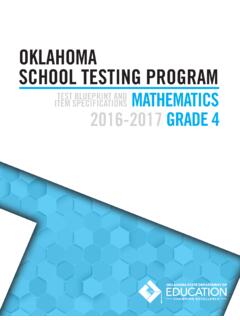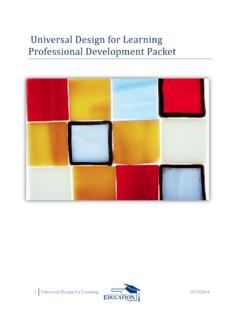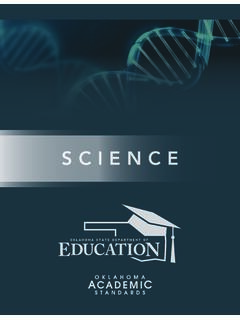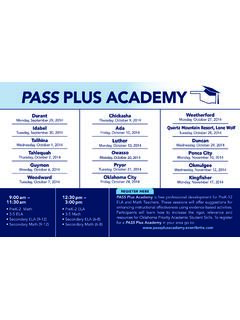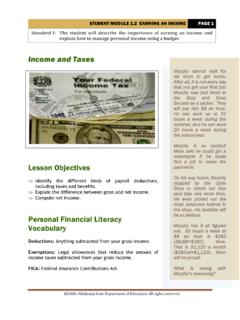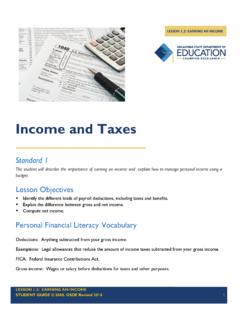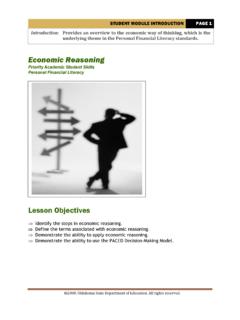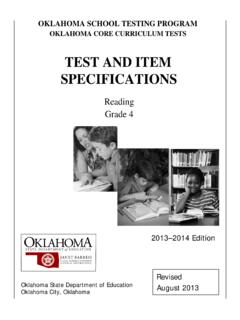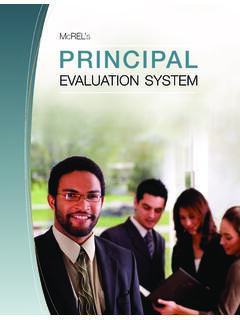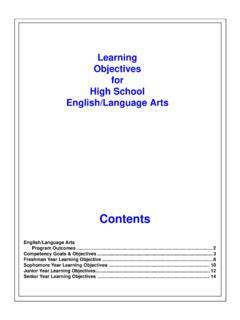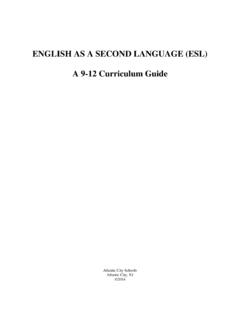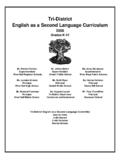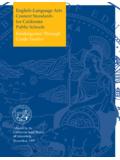Transcription of Oklahoma Academic Standards ENGLISH LANGUAGE ARTS
1 EducationOklahoma Academic StandardsENGLISH LANGUAGE arts Table of Contents 2 Oklahoma Academic Standards for ENGLISH LANGUAGE arts Introduction Guiding Principles 3 Grade 5 62 Eight Overarching Standards 6 Grade 6 72 Navigating the Standards 9 Grade 7 80 Pre-Kindergarten 10 Grade 8 88 Kindergarten 16 Grade 9 96 Grade 1 24 Grade 10 104 Grade 2 34 Grade 11 112 Grade 3 44 Grade 12 120 Grade 4 53 Guiding Principles Teachers use Standards as guides for developing curriculum and instruction that is engaging, challenging, and sequenced for the students in their care. By nature, acquiring LANGUAGE arts knowledge and skills is a recursive learning endeavor: students revisit concepts again and again as they use LANGUAGE at increasingly sophisticated levels. Because of this recursive learning process, LANGUAGE arts learning will not progress for students in the strictly linear way it may in other content areas. Nonetheless, it is important for any set of Standards to provide concise, written descriptions of what students are expected to know and be able to do at a specific stage of their education (Great Schools Partnership, 2014).
2 In order to make this document a clear, coherent description of what students are expected to know and be able to do at specific stages, the writers have adopted some guiding principles for design and organization: clarity, coherence, and purpose. Clarity Standard statements are written with verbs that indicate specifically what learning students must demonstrate and at what depth. When students compare, paraphrase, predict, or summarize, they are able to show a broader range of mastery of a concept than when they are expected to identify or recognize . However, the writers also have given full consideration to the complexity of the content itself. For example, it is more challenging to identify the implied theme of an extended essay than to identify the subject of a sentence. The progression of ENGLISH LANGUAGE arts learning from pre-kindergarten through high school should reflect the relationship between the level of critical thinking students use and the actual listening, speaking, reading, and writing experiences students have.
3 Content to be emphasized and assessed at specific grade levels is clearly identified. Some objectives are formatted with bullets for easier reading; bulleted skills can be learned in any particular order. In order to align with research on the science of reading, some objectives in Standard 2 Reading and Writing Foundations use lowercase letters for their bullets to indicate a researched-based sequence of learned skills. When lowercase letters are used instead of bullets, this shows a general sequence for how these skills would build upon one another. In this sequence, students practice a skills before practicing b skills and so on. While research supports this general sequence, some curriculum resources may use a slightly different sequence, and the fidelity of the curriculum resource should be honored. When a parenthetical phrase or statement is used to provide further clarity to an objective, and are sometimes used. = those are the only things to consider (Latin for that is ) = those are just some possible examples (Latin for for example ) Additional guidance and support documents will be provided on the ELA website ( ) and the Oklahoma Curriculum Framework for ENGLISH LANGUAGE arts ( ).
4 3 Oklahoma Academic Standards for ENGLISH LANGUAGE arts Introduction Coherence The Oklahoma Academic Standards for ENGLISH LANGUAGE arts identify the knowledge and skills that Pre-K 12 students should know and be able to do by the end of a grade level; each standard for every grade is delineated at the appropriate level. The Standards are presented by individual grade level with the reading and writing strands in a side-by-side format, encouraging an integrated approach to ENGLISH LANGUAGE arts . When a skill is no longer present, mastery is implied; however, teachers must support previous grade-level skills according to the mastery level of their students. For some grade levels in the Standard 5 LANGUAGE writing strand, the grade of mastery is indicated for some mechanics skills. The encoding objectives in the Spelling/Encoding section of Standard 2 Reading and Writing Foundations will often mirror the decoding Standards from the previous grade in the Phonics and Word Study section of the same standard.
5 Users must examine all of the Standards for each grade level as a whole to have a coherent understanding of what is required of learners. Because of the interconnectedness of LANGUAGE arts concepts and skills, various aspects of what students know and can do may be described in more than one standard. For example, learners conducting research (Standard 6) should use listening and speaking (Standard 1), reading and writing processes (Standard 2), Academic vocabulary (Standard 4), critical reading and writing (Standard 3), formal grammar and usage (Standard 5), and more than likely, they will access research and complete their research products because they are competent in multimodal literacies (Standard 7). As students progress through grade levels, expectations encompass the content of the previous grades. Specifically, in connection to reading assignments, the complexity of texts increases as students advance to later grades; however, simpler texts can be used effectively in order for learners to develop a deeper understanding of content such as theme, figurative LANGUAGE , genre, and structure.
6 4 Oklahoma Academic Standards for ENGLISH LANGUAGE arts Introduction Purpose In addition to a commitment to clear and coherent Standards , the writers were guided by four fundamental purposes of ENGLISH LANGUAGE arts education. LANGUAGE arts classroom is a place that is inclusive of the identities that reflect the richness and diversity of the human experience. All learners must hear the voices of their own heritage in the literature they encounter. They must also be given the opportunity to speak with the voices they choose for themselves in the writing they create. learners are supported to become independent readers in a range of disciplines . The ability to interpret literature as well as informative, highly technical, and often lengthy reading passages on one s own is paramount in achieving Academic and career success. Furthermore, learners who possess the skills required to read independently have the power to choose both what they need and what they want to read.
7 Learners are supported to become independent writers for a variety of audiences and a range of purposes . Independent writers are able to access multiple strategies and formats to communicate and craft their message, so it resonates with their intended audience. After students graduate high school , their writing skills remain critical, empowering them to express themselves in multiple modes and avenues, both professionally and personally. literate citizenry possesses the skills required to analyze, evaluate, act upon, and compose a wide range of communications . An ultimate goal of LANGUAGE arts education is the development of informed citizens who can contribute to the common good. 5 Oklahoma Academic Standards for ENGLISH LANGUAGE arts Introduction 8 Overarching Standards The following eight Standards encompass the content and competencies of ENGLISH LANGUAGE arts : and Speaking and Writing Foundations/Process Reading and Writing Literacies Reading and Writing The eight overarching Standards reinforce LANGUAGE arts recursive nature, a non-linear process that involves the continuous and thoughtful refinement of concepts and skills.
8 Each standard statement is accompanied by two strand statements listening and speaking for Standard 1 and reading and writing for Standards 2-8. Each pair of strands contains grade-level objectives. Standard 2 Reading and Writing Foundations includes the five strands of Phonological Awareness, Print Concepts, Phonics and Word Study, Spelling/Encoding, and Fluency. The linear order of the strands suggests a learning progression that begins with basic foundational skills and culminates in fluent readers and writers. Concepts and skills are expressed in terms of both reading and writing to support integrated, rather than isolated, reading/writing instruction. Research supports this integrated model of ENGLISH LANGUAGE arts , where students read to understand the meaning and composition of a text and write with readers expectations and assumptions in mind. The order of the Standards is meant to suggest that students learn to read and write by listening and speaking (Standard 1) on their way to the ultimate goal of becoming independent, critical readers and writers ( Standards 3 and 8).
9 At the same time, speaking and listening skills will continue to be developed as students progress through the grade levels, and concepts of independent reading and writing will be introduced even in the earliest grades. Independent reading and writing is a natural outgrowth of strong Standards implementation through a rigorous curriculum. Standard 8 acknowledges students need to grow increasingly independent for college and career readiness. Being able to work independently and seek out opportunities to read and write is a significant part of life-long learning . These skills easily transfer to test-taking, civic engagement, and citizenship. Academic Standards establish objective performance criteria. They are used as guides to develop curriculum and instruction that is engaging, challenging, and sequenced for students. Acquiring ENGLISH LANGUAGE arts knowledge and skills is a recursive learning endeavor. Students need to revisit concepts as they develop LANGUAGE arts acumen at increasingly higher levels of complexity.
10 6 Oklahoma Academic Standards for ENGLISH LANGUAGE arts Introduction The eight overarching standard statements are accompanied by two strand statements listening and speaking for Standard 1 and reading and writing for Standards 2-8. Standard 2 Reading and Writing Foundations includes five unique strands and statements related to foundational literacy skills. Every strand contains grade-level objectives. Standard 1: Listening and Speaking | Students will listen and speak effectively in a variety of situations. Listening : Students will develop and apply effective communication skills through active listening. Speaking : Students will develop and apply effective communication skills to share ideas through speaking. Standard 2: Reading and Writing Foundations | Students will develop foundational skills for reading and writing proficiency by working with sounds, letters, and text. Phonological Awareness : Students will recognize, count, and manipulate the parts of spoken words, including syllables, onset/rimes, and phonemes without using text.
